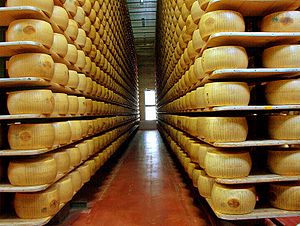 Image via Wikipedia
Image via WikipediaSince starting our meatless regimen on Sunday, I've enjoyed a lot of cheese -- glorious cheese.
Cheese is one of those fatty foods I have been careful about. Although I have never met a cheese I didn't like, being lactose-intolerant has never made it an easy choice.
Usually, I had only Parmigiano-Reggiano (photo) in the fridge, because it is made with skim milk, and a sliced yogurt cheese with jalapenos I buy at Trader Joe's. Lately, I've expanded to a thin-sliced, lactose-free Swiss cheese from Costco.
Two farms in North Jersey, Bobolink Dairy in Vernon and Valley Shepherd Creamery in Long Valley, have wonderful, artisanal cheeses I have enjoyed occasionally, and I've lost count of the "lunches" I've made of the free cheese samples at Jerry's in Englewood.
Looking for a meatless lunch today at The Famished Frog in Morristown, I chose the vegetable panini, and it was filled with a gooey cheese, probably mozzarella, along with a meaty mushroom and other veggies. It was a little bland until I added Dijon mustard.
Our meatless meal tonight was Canadian flounder fillets, which cooked in under 10 minutes in a covered pan with Mexican green salsa, and gourmet fingerling potatoes, boiled and then sauteed in oil with onion and sweet pepper.
![Reblog this post [with Zemanta]](http://img.zemanta.com/reblog_a.png?x-id=4c40e1f7-b002-4a3d-9298-4ffdd47e2fb7)



